#organisms! specifically eukaryotes
Explore tagged Tumblr posts
Text
Filters in the way of technologically advanced life in the universe and how likely I think they are
1. Abiogenesis (4.4-3-8 billion years ago): Total mystery. The fact that it happened so quickly on Earth (possibly as soon as there was abundant liquid water) is a tiny bit of evidence for it being easy. Amino acids and polycyclic hydrocarbons are very common in space, but nucleotides aren't, and all hypothetic models I've seen require very specific conditions and a precise sequence of steps. (It would be funny if the dozen different mechanisms proposed for abiogenesis were all happening independently somewhere.)
2. Oxygenic photosynthesis (3.5 billion years ago) (to fuel abundant biomass, and provide oxygen or some other oxidizer for fast metabolism): Not so sure. Photosynthesis is just good business sense -- sunlight is right there -- and appeared several times among bacteria. But the specific type of ultra-energetic photosynthesis that cracks water and releases oxygen appeared only once, in Cyanobacteria. That required merging two different photosynthetic apparati in a rather complex way; and all later adoptions of oxygenic photosynthesis involved incorporating Cyanobacteria by endosymbiosis. For all that it's so useful, I don't know if I'd expect to see it on every living planet.
3. Eukaryotic cell (2.4 billion years ago?): Probably the narrowest bottleneck on the list. Segregated mitochondria with their own genes and a nucleus protecting the main genome are extremely useful both for energy production (decentralized control to maximize production without overloading) and for genetic storage (less DNA damage due to reactive metabolic waste). But there's a chicken-and-egg problem in which incorporating mitochondria to make energy requires an adjustable cytoskeleton, but that consumes so much energy it would require mitochondria already in place. Current models have found solutions that involve a very specific series of events. Or maybe not? Metabolic symbiosis, per se, is common, and there may have been other ways to gene-energy segregation. Besides, after the origin of eukaryotes, endosymbiosis occurred at least nine more times, and even some bacteria can incorporate smaller cells.
4. Sexual reproduction (by 1.2 billion years ago): Without meiotic sex (combining mutations from different lineages, decoupling useful traits from harmful ones, translating a gene in multiple way), the evolution of complex beings is going to be painfully slow. Bacteria already swap genes to an extent, and sexual recombination is bundled in with the origin of eukaryotes so I probably shouldn't count it separately (meiosis is just as energy-intensive as any other use of the cytoskeleton). Once you have recombination, life cycles with spores or gametes and sex differentiation probably follow almost inevitably.
5. Multicellularity (800 million years ago?): Quite common, actually. Happens all the time among eukaryotes, and once in a very limited form even among bacteria. Now we'd want complex organized bodies with geometry-defining genes, but even that happened thrice: in plants, fungi, and animals. As far as I know, various groups of yeasts are the only regressions to unicellularity.
6. Brains and sense organs (600 million years ago): Nerve cells arose either once or twice, depending on whether Ctenophora (comb-jellies) and Eumetazoa (all other animals except sponges) form a single clade or not. Some form of cellular sensing and communication is universal in life, though, so a tissue specialized for signal transmission is probably near inevitable once you have multicellular organisms whose lifestyle depends on moving and interacting with the environment. Sense organs that work at a distance are also needed, but image-forming eyes evolved in six phyla, so no danger there (and there's so many other potential forms of communication!). Just to be safe, you'll also want muscles and maybe mineralized skeletons on the list, but I don't think either is particularly problematic. An articulated skeleton is probably better than a rigid shell, but we still have multiple examples of that (polyplacophorans, brittle stars, arthropods, vertebrates).
7. Life on land (400 million years ago): (Adding this because air has a lot more oxygen to fuel brains than water (the most intelligent aquatic beings are air-breathers), and technology in water has the issue of fire.) You're going to need a waterproof integument, some kind of rigid support system, and kidneys to regulate water balance. Plenty of animal lineages moved on land: vertebrates, insects, millipedes, spiders, scorpions, multiple types of crabs, snails, earthworms, etc. Note that most of those are arthropods: this step seems to favor exoskeletons, which help a great deal in retaining water. Of course this depends on plants getting on land first, which on Earth happened only once, and required the invention of spores and cuticles. (Actually there are polar environments where all photosynthesis occurs in water, but they are recently settled and hardly the most productive.)
8. Human-like intelligence (a few million years ago?): There seems to a be a general trend in which the max intelligence attainable by animals on Earth has increased over time. There's quite a lot of animals today that approach or rival apes in intelligence: elephants, toothed cetaceans, various carnivorans, corvids, parrots, octopodes, and there's even intriguing data about jumping spiders. Birds seem to have developed neocortex-like brain structures independently. Of course humans got much farther, but the fact that even other human species are gone suggests that a planet is not big enough for more than one sophont, so the uniqueness of humans might not necessarily imply low probability. (We seem to exist about halfway through the habitability span of Earth land, FWIW.) The evolution of sociality should probably be lumped here: we'll want a species that can teach skills to its offspring and cooperate on tasks. But sociality is also a common and useful adaptation: many species on our list (octopodes are a glaring exception) are intensely social and care for their offspring. I mentioned above that the land-step favors exoskeletal beings, which in turns favors small size; but the size ranges of large land arthropods and very intelligent birds overlap, so that's not disqualifying.
9. Agriculture and urban civilization (11,000 years ago): Agriculture arrived quite late in the history of our species, but when it arrived -- i.e. at the end of the Wurm glaciation -- it arrived independently in four to eight different places around the world, in different biogeographic realms and climates, so I must assume that at least some climate regimes are great for it (glacial cycles are a minority of Earth's history; but did agriculture need to come after glaciations? Maybe a shock of seasonality did the trick). And once you have agriculture, complex urbanized societies follow most of the time, just a few millennia later. Even writing arose at least three times (Near East, China, and Mexico), and then spread quickly.
10. Scientific method and industrialization (300 years ago): We're getting too far from my expertise here, but whatever. The Eurasian Axial Age suggests that all civilizations with a certain degree of wealth, literacy, and interconnection will spawn a variety of philosophies. Philosophical schools that focus on material causes and effects like the Ionians or Charvaka have appeared sometimes, but often didn't win over more supernaturalist schools. Perhaps in pre-industrial times pure materialism isn't as useful! You may need to thread a needle between interconnected enough to exchange and combine ideas, and also decentralized enough that the intellectual elite can't quash heterodoxy. As for industrialization, that too happened only once, though that's another case in which the first achiever would snuff out any other. I hear Song China is a popular contender for alternative Industrial Revolutions (with coal-powered steelworks!); Imperial Rome and the Abbasid Caliphate are less convincing ones. For whatever reason, it didn't take until 18th century Britain.
11. Not dying randomly along the way: Mass extinctions killing off a majority of species happened over and over -- the Permian Great Dying, the Chicxulub impact, the early Oxygen Crisis -- but life has always rebounded fairly quickly and effectively. It's hard enough to sterilize an agar plate, let alone a planet. Disasters on this scale are also unlikely to happen in the lifespan of planet-bound civilizations, unless of course the civilizations are causing them. A civilization might still face catastrophic climate change, mega-pandemics, and nuclear war, not to mention lesser setbacks like culture-wide stagnation or collapse, and I couldn't begin to estimate how common, or ruinous, they would actually be.
****
I have no idea how common the origin of life is, but the vast majority of planets with life will only have bacterial mats and stromatolites. Of the tiny sliver that evolved complex cells, a good chunk will have their equivalents of plants and animals, most of which may have intelligent life at least on primate- or cetacean-level at some later point. At any given time, a tiny fraction of those will have agricultural civilizations, at an even tinier fraction of that will have post-industrial science and technology. Let's say maybe 1 planet with industrial technology out of 100 with agriculture, 100,000 with hominid-level intelligence, 10 million with animal-like organisms, 100 millions with complex cells, and 10 billions with life at all?
180 notes
·
View notes
Text
cant get over the fungi on ruidus sorry. i have more to say
its implied that the reilorans are able to survive and farm the fungus, theres at least 347 different species of fungus native (?) to ruidus, and theres also slime molds*. evolutionarily (assuming the life evolved independently on ruidus which is a very bold assumption) this would imply that theres also prokaryotic life (bacteria, basically) and likely advanced eukaryotic organisms in the form of animal life, which we do see! its very possible that the reason theres so little plant life on ruidus is because something about the makeup of the planet is aggressively harmful to plants, if i had to guess its the lack of easily available sunlight due to the constant dust storms and the soil is probably unfavorable for growing. this probably means that fungus makes up the majority of the biomass for animals to consume or animals are much more adapted for absorbing nutrients from the soil/other sources.
i do think its interesting that fungus seem to survive and thrive SO well in the deep caverns because most fungus (on earth, and exandria. probably) are decomposers and need organic material to survive off of. they could be decomposing the crystal corpse of predathos though, which is the coolest idea in the world to me, or they could just do so well that they've created an independent ecosystem underground complete with its own n- and c-cycles.
the fungus on ruidus seem to take more after kingdom animalia in general, since theyre motile (for those unawares, fungus are actually MUCH much much more related to animals than they are to plants, so this isnt that out there) which is super cool. the myceits are somehow related to the fungi's sexual reproduction because we see the sterile mycelium on it's own and it doesn't seem to be producing any spores, where the myceits do have spore producing structures (specifically they have hymenophores, since they are most similiar to hymenomycete mushrooms). so i think its likely the myceits are just advanced forms of spore dispersal and will run around till they find somewhere favourable to drop spores (or passively will drop them as they move) and probably they have very short life spans </3 sorry myceits
also myceit = mycete = fungi kingdom. proof of earth-equivalent taxonomy existing in exandria? possibly why the ruidians call them myceits is because theyve seen botanists dream about mushrooms and refer to them as "mycetes" !
*gaz, the source for the # of fungus, seems to consider slime molds a kind of fungus, so its unclear whether all the species are actually true fungi, but i digress because slime molds are closely related to fungus anyway. also 347 is a really low number of species for an entire planet, but whatever.
#dont look that closely into how things could have evolved from bacteria at all without an ocean....... shhhhhhhh#im afraid that the nerd brain is chronic. i love to learn and to apply knowledge#sorry im in my botany head era right now. im done with my general botany course and all the info just needs somewhere to go#why not use it for some interesting analysis on ruidus. im sure at least one of my followers enjoys this yapping#ramblings#cr spoilers#bc its using info from the most recent ep as if anyone cares about fungus spoilers. LOL#critical role
99 notes
·
View notes
Note
huh...
So when the Archivist find a planet capable of sustaining life but currently without life, they... Release single celled organisms? ...Just to archive them in the future? That's so odd to me.
Why not just wait, is archiving some sort of deep-seated urge or instinct that they NEED to do? Isn't it counterproductive to not just let life naturally develop, or is artificially creating new life apart of the reason they exist?
The short answer (its kinda a tdlr, the text got long)
So life develops slowly and needs stable conditions, what is hader when things like stars have finite lifespans (our Sun is already halfway through!). The Starchildren can’t create life or bring it back, and not all planets have the right conditions for it to start in time when planet is habitable, but might adapt once it’s there. They treat planets bit like gardens in a region where apocalypses are common, with the Archive serving as a storage for seeds, saplings, and tools. Its more usable and not as much lifeless museum of life
Most planets do well on their own, so only parts are collected but beyond that left alone, and some are destroyed or struggle to progress beyond microbes. In those cases, they might step in to improve conditions or remove threats. Sometimes, they just observe how life adapts to what chaos it has. If it can.
There are also personal reasons for work, things like attachment or desire for control, but their mission began when the first life-sustaining planet was destroyed, leaving them alone in the void believing everything was lost forever. When life SLOWLY re-emerged on other worlds, they began preserving and protecting it, spreading across the void.

Long answer under the cut
Life in general develops extremely slowly. Earth is around 4.5 bln years old (Ga), it's estimated that it took around 1,1Ga to go from anoxygenic bacteria to aerobic bacteria (after some ox producing bacteria ruined the party for all those who couldnt deal with it, also called Great Oxygenation Event). From there, it took roughly 0,5 Ga for eukaryotic cells to develop. Shortly after (like 0.1 Ga), life transitioned from single-celled to multicellular organisms. In comparison it took 1.7 Ga for evolution to progress from algae to humans—about 1.6x faster than the journey from primordial soup to microbes
There could be planets capable of supporting life that are just off the mark, preventing organic material from developing well enough. Some might have all the right conditions but lack the right combination of energy sources, maybe too far from a star, maybe something else. But, once life forms and we get a "Last Universal Common Ancestor" (LUCA) It could spiral to the point where, as on Earth, almost no surface remains untouched by life (you really don’t want to know how many bacteria are on your phone). But thats only really because life got a really good footing here. If a catastrophic event wiped out all complex life, bacteria adapted to extreme would probably be fine and maybe evolve further.
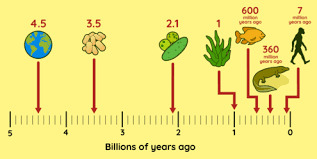
If primitive cells formed under specific conditions and those suddenly changed, all that progress could halt or go back entierly to a primordial soup (Going with the Heterotrophic Theory, this is my gen favourite term for this, soup). And there is another aspect. Suns are not eternal; our sun, at ~4.5 Ga, is already halfway through its lifecycle before becoming a red giant. At that point, Earth will lose its "habitable" status. If Earth went through a hard reset, and assuming everything went the same, next intelligent life might be one witness their star’s death, sooo there is a finite window of habitability.
Each evo step is faster than the last one, Archivists intervene at mostly early stages making the beginning bit smoother, more controlled. They aim to make planets with potential more habitable or stoping them from losing it. For example they might create an atmosphere if one lacks it but is otherwise perfect, and past that let life develop naturally.
And even with perfect conditions, factors like astronomical events could mess up whole process. In the infinite space it's not really a question of if but more which planet heads into a catastrophe, so they stay around. Archive functions like a backup, preserving progress where possible. If a planet faces extinction, they might change the enviroment, whatever is esponsible for it, maybe introduce creatures more capable of surviving—or even short-lived organisms, some that arent meant to survive but will provide enough short term nutrients for the native organisms to pull through.
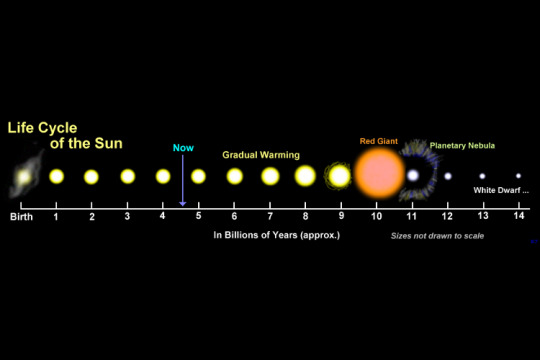
That being said they usually try to avoid too much interferance, sometimes its just patching up small element before it becomes an problem. But sometimes they will just stay clear. If one is doing okay or particularly fascinating they'll stay back and watch how it adapt to the unique environments. World where due to temperatures the only habitable zone is on the edge of a star’s light? Organisms adaptation might give some insight for future and give templates for backing up similar ecosystems elsewhere. But there are limits to their interference. If saving a planet requires more effort than its results justify, they let it fade, something Wayfarer was upset about
There’s also a personal element. Archivists sometimes release life forms they’re familiar with—ancestors of creatures they once befriended. While they know these won’t develop into the same beings, it’s comforting to see familiar traits re-emerge (and to know how to deal with them). When universe is so hellbend on reminding of inevitable end, its a small victory.
Those are some words about methods, when it comes to why they even start its bit diffrent. The Starchildren’s mission stems from witnessing the first total extinction of life on a first developed planet. Unable to create life or reverse what had happened, they were confronted with the vast emptiness of the void and believed all was lost, that was it. And then saw the painfully SLOW emergence of life elsewhere, collectors agreed on a mutual goal to prevent life fading out of existance, not taking for granted it will work out. Bit ironic joke of fate that ones suited to live in isolation of void are also one to seek company. When the only other comapny is one that lives in blink of an eye its easy for the unguided Starchildren with almost divine power develop some quirks and complexes (not an excuse, just a reason).
But maybe its by design, just the right trait to have something always watching tirelessly over the gardens, ensuring there is someone there. I wouldn't say there isn't a quiet internal push for it, a drive that took root in the right environment and grew into a lifelong mission. Magic, like energy, isn’t created—it once formed part of Everything. When Everything awakened, it wanted to be more, sought to ensure there would always be something
#Thatssss a long one i wrote it on my notebook a while ago and took a moment before transcribing#toh#the owl house#toh archivists#the archivist#toh collectors#toh fanart#owl house#the collector#toh collector#regulart#ask#toh the collector#the collector toh#collector toh#sketches#toh comic#toh the archivists#the archivists#c:i architect#c:i anatomist#c:i wayfarer#c:i Curator
55 notes
·
View notes
Text
Monday's Musings: The Development of Biomineralization

William Buckland first noted the seemingly rapid appearance f fossils in Cambrian strata in the 1840's.

And Charles Darwin discussed the then inexplicable lack of earlier fossils as one of the main difficulties for his theory of descent with slow modification (natural selection) in his 1859 book which you've probably heard of.
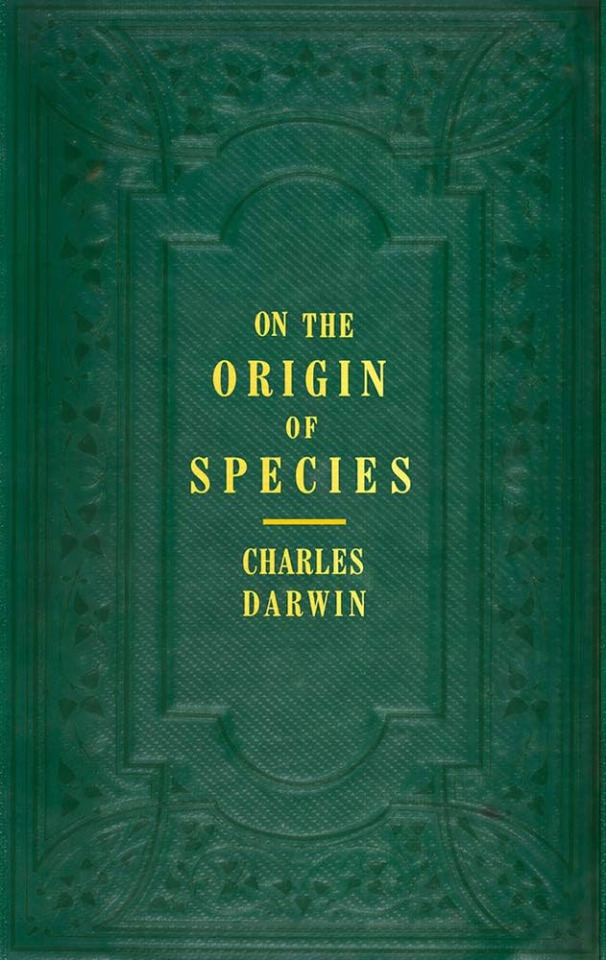
This seemingly sudden appearance of fauna raised three big questions: was there actually a mass diversification of complex organisms over a relatively short time during the early Cambrian? What caused such rapid change? What does it imply about the origin of early animal life?

Edward Lhuyd, the curator of Oxford Museum in 1698, first discovered Cambrian fossils in the forms of trilobites. From that point on, trilobites became some of the most important fossils for dating Paleozoic rocks (these are called index fossils). Buckland recognized that a dramatic step-change in fossils occurred near the base base of the Cambrian thanks to trilobites and Adam Sedgwick and Roderick Murchison used them for dating Cambrian and Silurian strata.

Charles Walcott suggested that there was an interval of time prior to the Cambrian fauna that did not preserve fossils or was simply not in the fossil record (maybe the rocks had eroded away before Cambrian deposition).
Today, we have fossil evidence that the earliest like goes back 3.8 billion years ago. Rocks of that age in Australia contain stromatolites,
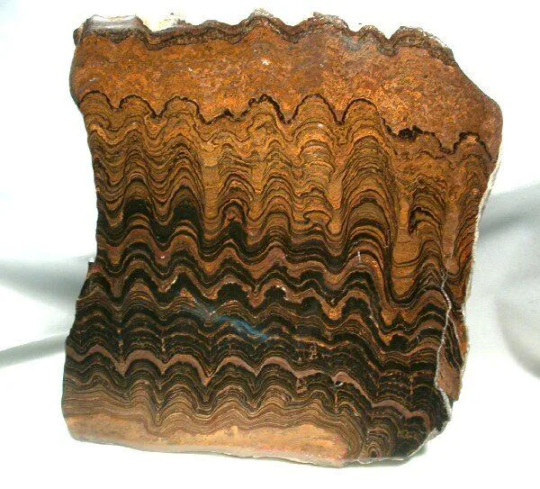
colonies of microorganisms called cyanobacteria.
Fossils of more complex eukaryotic cells called Grypania have been found in China and Montana in rocks dating 2.1 billion years old.
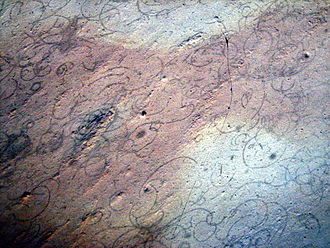
Rocks from about 600-541 Ma have also been found to contain fossils that we now call the Ediacaran Biota but that deserves a post all on it's own.
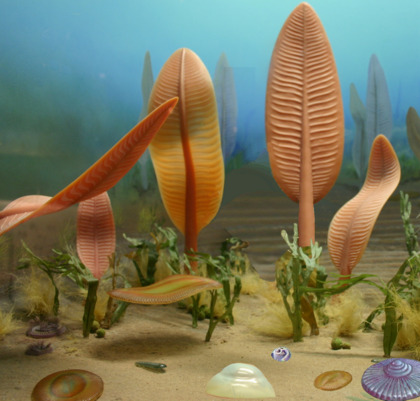
A reevaluation of the Burgess Shale fauna in the 1970's sparked a renewed interest in the explosion.

Harry B. Whittington realized that many of the animals Walcott had found were just as complex as modern animals but they were also very different. He noted that Marella was clearly an arthropod but not a member of any known class.
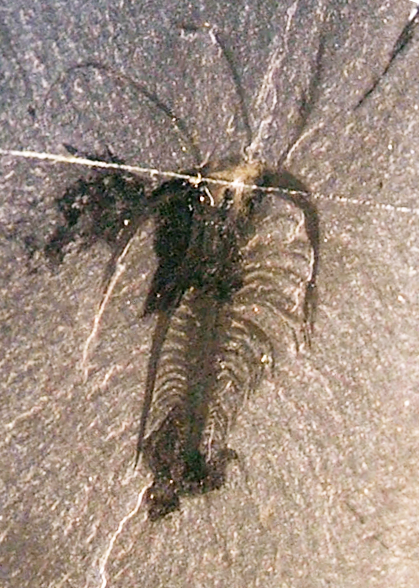
He also noted that animals like Opabinia and Wiwaxia were so different than anything alive that they must belong to their own phyla.
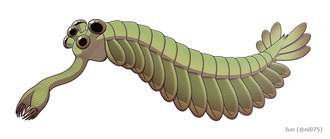
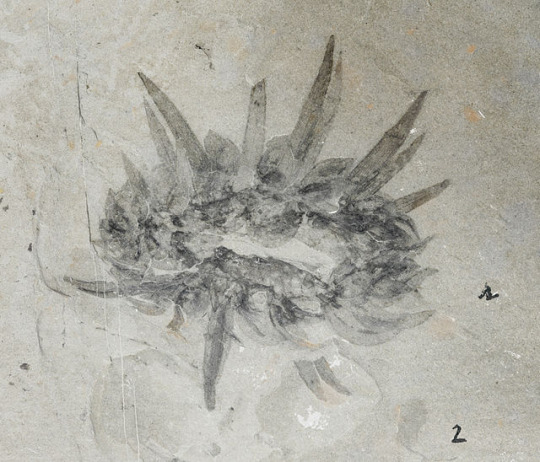
Now, we know that there was complex life at the end of the Proterozoic Eon so the Cambrian is not the "beginning of life" like we used to believe. So, why is the Cambrian explosion still so important?
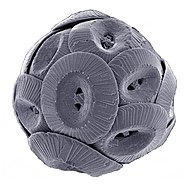
Biomineralization. This is the time period where hard parts began to develop. This is the process by which living organisms produce minerals often resulting in hardened or stiffened mineralized tissues. An example you probably don't think about is your own skeleton. Your skeletal tissues are made up of collagen and calcium phosphate. Other types of biomineralization include silicates in algae and diatoms (these often create chert in limestone) and carbonates (such as chalk) in invertebrates.
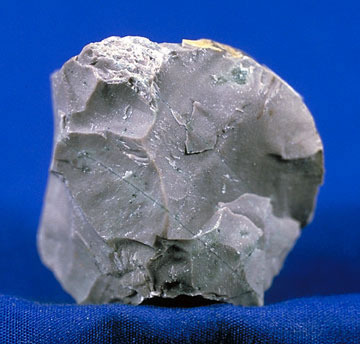
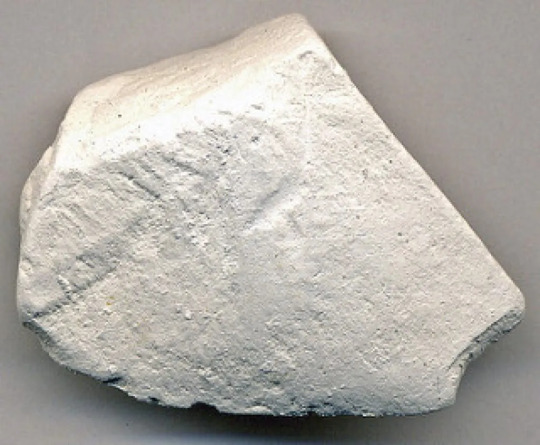
Why did hard parts start showing up in the early Cambrian and not before? One hypothesis is that atmospheric oxygen was finally high enough to allow metabolisms to work efficiently enough to create collagen, a protein made of amino acids that provides structural support in connective tissues.
Another hypothesis is an increase in the concentration of calcium in seawater. Animals that create hard parts from calcium carbonate do so in a very specific way. First, carbon dioxide gas must be dissolved in seawater. It then reacts with the water to create bicarbonate and hydrogen ions. That bicarbonate then reacts again with the water and creates carbonate and hydrogen ions.

Calcium is also an ion just floating about in the water column. Animals then absorb these ions.
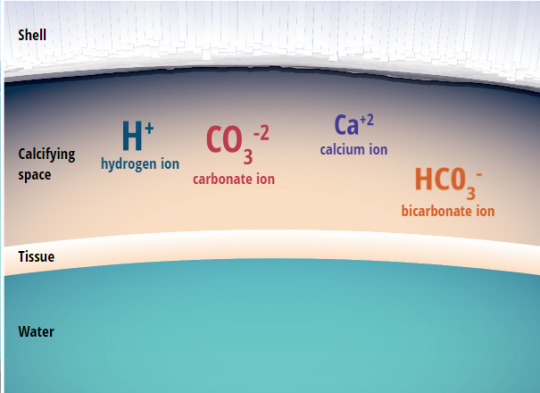
The calcium ions bond with the carbonate ions to form calcium carbonate crystals inside the shell.
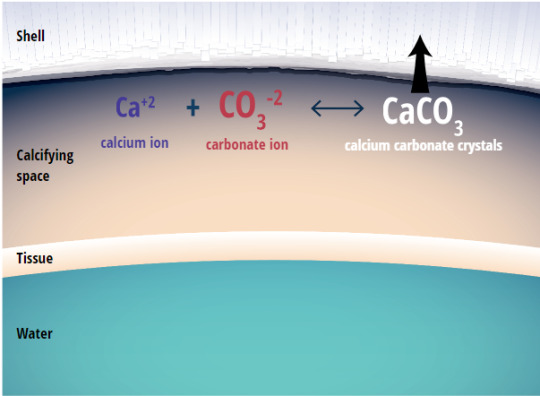
This increase in calcium could also have caused a high rate of erosion (a thought for another Monday).
A final hypothesis is that of predator-prey competition. There is evidence of predation in the Ediacaran fauna such as holes drilled into animals called Cloudina. While the appearance of predation wouldn't trigger hard part development, an increase in predators probably would. In the Burgess Shale alone there are dozens of carnivorous worms, anomalocarids and other arthropods, carnivorous molluscs, lobopods and early jellyfishes that would predate opportunistically.
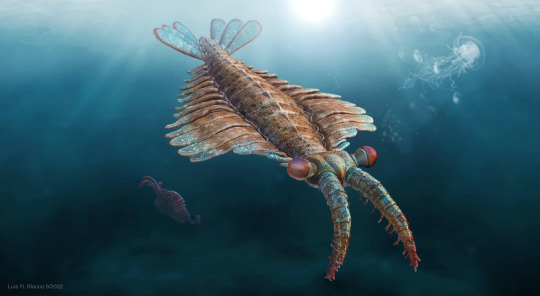
Likely, it was a combination of all these things that led to the rapid development of hard parts. And hard parts stuck around too! Thank goodness or my job would be even harder than it already is.
Fossilize you later!
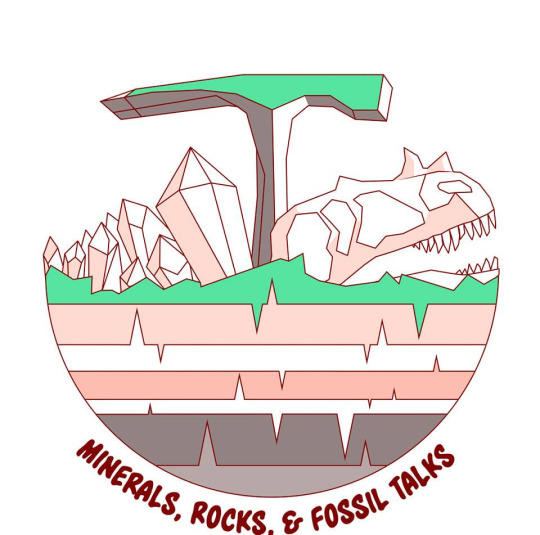
#paleontology#fossils#fun facts#geology#mineralogy#minerals#history#trilobites#anomalocaris#hard parts#cambrian explosion#cambrian period#ediacaran#life finds a way
63 notes
·
View notes
Note
What is a favorite fact that you like but feel like you never have a chance to share? More than one favorite is also totally acceptable.
This is a tough one because as soon as I learn a new fact I tell everyone around me that fact repeatedly. Some of my favs:
Our fuel doesn't come from dinosaurs as the internet likes to say but actually mostly fossilized algae and plant matter!
Barnacles may have the largest penis to body size ratio of any animal.
Our mitochondria was actually it's own little organism before "we" (the single celled ancestor of all eukaryotes) swallowed it up and instead of digesting it, put it to use. That's why mitochondria have their own set of DNA. All human mitochondria can in theory be traced back to a "mitochondrial Eve" because we inherited 100% of our mitochondrial DNA from our mother and there is very little recombination compared to the rest of out DNA. There is also a y-chromosome Adam but that's only traceable in much more recent history because of more recombination and mutation, and also because only half the population have y-chromosomes.
Antlers are actually technically a type of cancer! In a simplified way, antlered animals have evolved to use these cancer cells and not be killed by them!
Soap is made from fats! Therefore bodies decomposing in specific cold low oxygen environments actually "turn into" soap in a process called saponification!
#science#facts#all of theses are really simplfied and anthropomorphized and if any really interest you you should read the primary lit!#They actually get MORE bizzar the more you read!
179 notes
·
View notes
Text
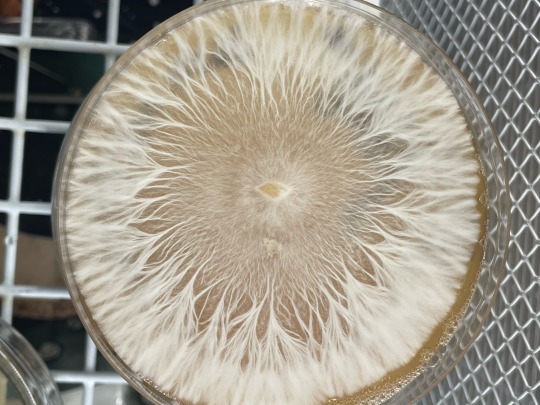
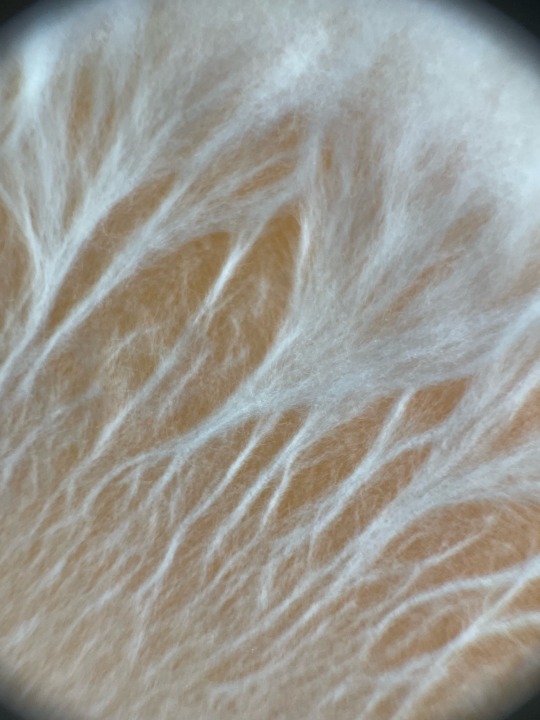


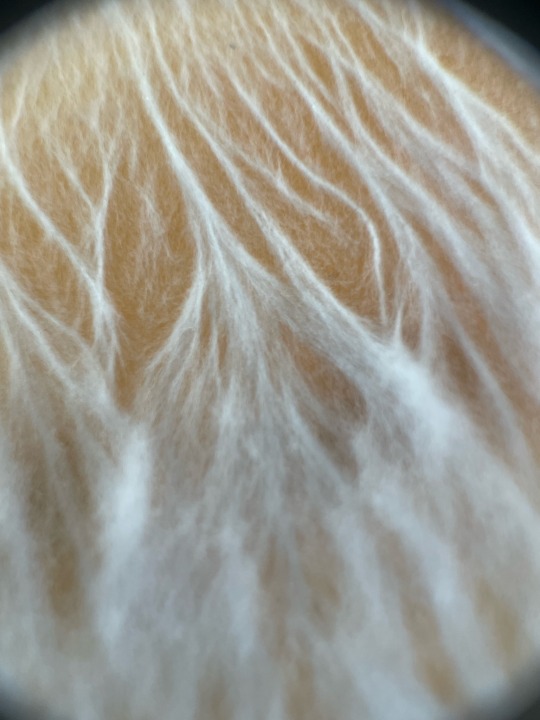
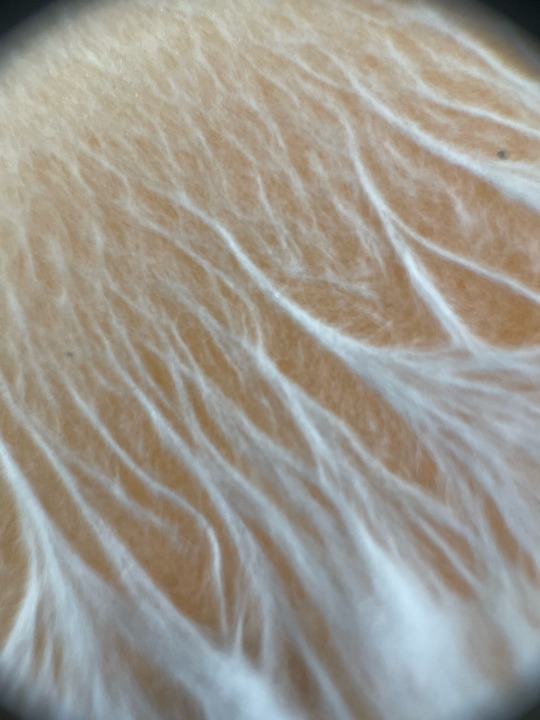

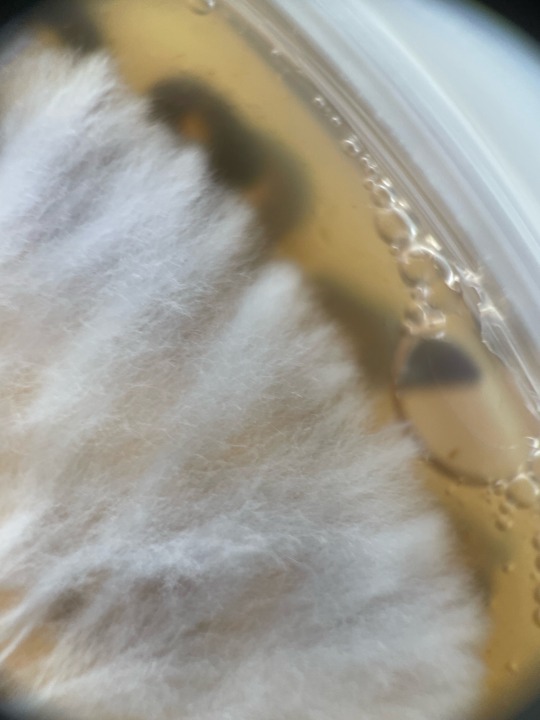
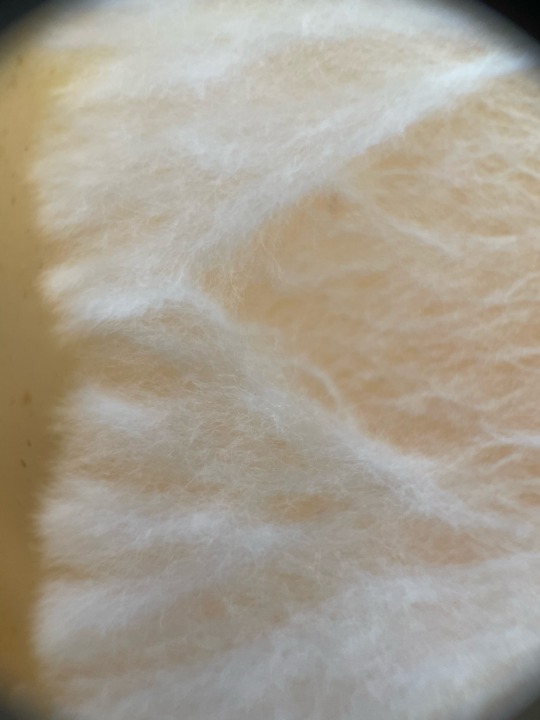

Macro examination of this beautiful “penis envy” plate! on this plate is a living, unique fungal organism, a multicellular eukaryote that produces mushroom fruit bodies as end stage of its reproductive cycle :) this plate show cases mycelium, or a collection of hyphae from any given fungal spores germination or tissue cloning, that form the mycelium Your eyes see. This colony is a specifically named isolate from multi spore syringe, a Psilocybe Cubensis variety named ‘Penis Envy’ (thanks to its specific fruit morphologies that carry over to subsequent generations of that variety) and a trait of blobbing ‘Dino egg’ fruit bodies for first flush and expected fruit bodies second flush🍄🍄🍄🍄
—
Follow for more!
patreon.com/mycochaotix
youtube.com/myco_chaotix
Instagram: @myco_chaotix
www.linktr.ee/mycochaotix
.
.
.
.
.
.
#mycology#lgbtqia2s#magic mushies#microbiology#mold#60s psychedelia#lgbtqia#lgbtqia2s+#myc#enby#mycelia#mycelium#mcx#mycochaotix#agar#plate#penis envy#pe#rhizo#mushroom#fungus#fungi#fungusamongus#queer#non binary#macro#photography
67 notes
·
View notes
Text

Identity
In terms of my otherkin labels, being bosmer is not one of them — I do not have a biologicaly human body at all, as I am mer.
I use the terms alterhuman, faekind, spriggankind, goblinkind, dragonkind, draconic, kelpkind, snakekind, serpentkind, pythonkind, viperkind, pixiekind and spritekind.

‘Kind

Spriggankind
Spriggans (Coille phytomorphis) are a type of forest fae. A majority of spriggans can be found in the Northern Hemisphere, inhabiting densely-wooded areas and taking care of the native wildlife. They are not friendly towards humans and often attack them unprovoked; otherwise, they avoid humans completely. They are more peaceful towards mer, but are still often hostile and violent. They have the best relations with bosmer, who they feel adhere to the values of Y’ffre the most strictly out of all the mer. They have a connection with all types of wildlife, but they share a spirit bond with bears and foxes. Their biology is somewhere in between plant and animal, and they consume soil, minerals, sand, decomposing plant and animal matter, as well as biological waste. However, they primarily drink water to sustain themselves and must drink a lot of it in order to function.

Goblinkind
Goblins (Puko hulbolig) are mistaken for being much more stupid and aggressive than they really are. While it is true that some goblins form hoardes, these events of pillaging are not universal. In truth, goblins form extremely close family ties, and typically reside in caves. Due to most caves in Tamriel being excavated and mined extensively, goblins were pushed out of their native homes and forced to live in exile in city sewers, underground Ayleid temples and ruins, and many of them returned to the caves they once occupied in rebellion. As a result, they are incredibly cautious of most bipeds, and have an instinct to defend themselves. They are omnivores and eat herbs, berries and tubers, along with some grasses. They eat small amounts of ground mineral ores to help them digest this (thus resulting in collecting money whenever they can, as their caves are mostly empty of ores they can safely use), as well as consuming animal meats — usually smaller animals such as weasels, rats, birds, and occasionally fish and shellfish.

Dragonkind
Azure dragons (Draconis veneta), sometimes appearing blue, green or turquoise depending on the lighting source, are a temperate forested coastal cliff-residing dragon, taking advantage of food sources such as dolphins, whales, sharks, seals, deer, wolves, ogres, boar, larger species of trolls, elk, cattle and horses. These dragons are opportunistic feeders but often develop preferences for specific prey items. They are also commonly found to be feasting on kelp, seaweeds and seagrasses. They are adept at swimming and diving, able to hold their breath for up to 20 minutes at a time. They are typically solitary, but will occasionally keep in contact with family, even sometimes forming small groups of friends, or visiting their mates’ family. They are highly elusive and are more often heard than seen, their call reaching an impressive distance of up to 30 miles.

Kelpkind
Giant kelp (Macrocystis pyrifera) is the largest species of brown algae. Brown algae is a large group of multicellular algaes — eukaryotic organisms that evolved the ability to photosynthesize later and separately from plants due to a developed mutualistic relationship between red alga and some kind of basal eukaryote. They live primarily in the Northern Hemisphere, inhabiting cold and icy waters, and are frequently found attached to rocky shores. They are a food and shelter source for an abundance of plants and animals, and provide a pivotal role in the ecosystems they thrive in.

Rattlesnakekind
Timber rattlesnakes (Crotalus horridus), native to eastern Turtle Island, are pit vipers with a powerful neurotoxic and hemorrhagic venom. They average around 4 ft in length, but some individuals have been found to be over 6 ft. They return to the same den every winter to brumate, often with friends and family. They are often found basking to warm themselves with these social groups, as well. They primarily consume squirrels, mice, rats, rabbits, birds and frogs. They hunt their prey by chemical detection and envenomation, striking a bite, and then waiting for their prey to succumb to the venom before consuming it. They inhabit grassy, forested and rocky areas, sleeping in hidden rocky outcroppings and solid burrows left behind by other animals. They are not aggressive, but they are defensive, showcasing their trademark rattling sound to serve as an announcement of their need for personal space.

Pythonkind
Royal pythons, or ball pythons (Python regius), are constrictor snakes native to sub-Sarahan West Africa, as north as Senegal, as east as Sudan and as south as Uganda. They are known for their round faces, their thick bodies and their striking patterns and bright colors, called “morphs” in the reptile industry. They eat gerbils, mice, rats, small birds, and occasionally, small reptiles. They are solitary, residing in burrows usually abandoned by other animals, but they will also dig their own, as well as inhabiting termite mounds every so often. They live in quite a diverse range, inhabiting grasslands to forests to wetlands, but they are not often found near water unless seasonal flooding is taking place. They are strong swimmers and have no issue using water as a means to escape danger. They are not venomous, using their ability to see heat and sense chemical changes in the air to track their prey, striking and constricting it until the prey is strangled.

Feurfae
Feurfae, or in English, grass pixies (Epiconias gramen), are a type of bipedal plant sprite. They have translucent iridescent wings, and their appearances mimic the lowest growing plants in their environment, allowing them to easily camouflage into their surroundings. Feurfae in particular are found in forests with significant underbrush, as well as grasslands and wildflower meadows, but they are never far from a forest due to their need to pollinate and their hunger for nectar. They eat flower nectar, honey, certain types of pollens and young seeds, flower petals, tree sap and honeydew (insect secretions). Pollen tends to stick best to their manes, arms, legs, back and tail. Feurfae posess incredibly sensitive whiskers and feelers, located on their snout, eyebrows and tail. Their feet resemble spider paws, and work the same way, making use of their retractable claws to grip onto the stems of plants and to the bark of trees. They are highly social creatures, and prefer only to be alone when hunting. Their height ranges from approximately 6.7mm to 2cm.

4 notes
·
View notes
Note
but if birds are dinos, are we still monkeys, or by a stretch, fishes? Microbes? Ok tahts a big stretchnactually, just fish
Aha! We are fish, but we're also Archaeans!
Microbe just means a microscopic organism. However, all eukaryotes descended from Archaeans - specifically, Asgardians - and thus, we are Archaeans!
With a surprise eubacteria (for some of us, more than one) inside :)
92 notes
·
View notes
Text
Propaganda!
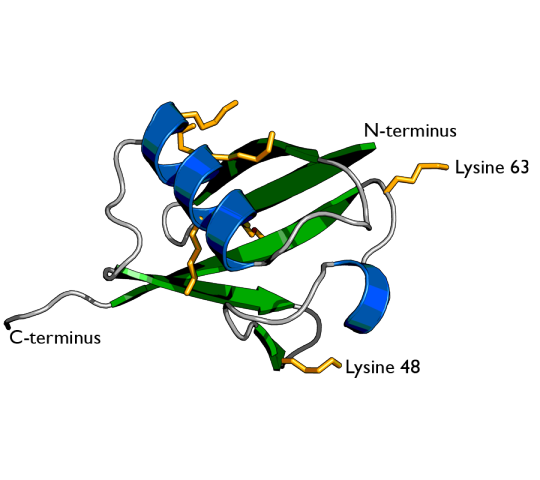
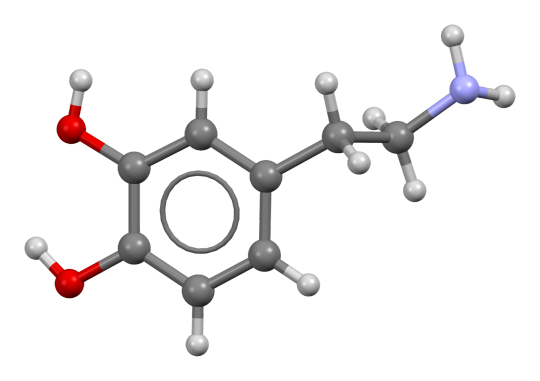
Ubiquitin is a small (8.6 kDa) regulatory protein found in most tissues of eukaryotic organisms, i.e., it is found ubiquitously. The addition of ubiquitin to a substrate protein is called ubiquitylation (or ubiquitination or ubiquitinylation). Ubiquitylation affects proteins in many ways: it can mark them for degradation via the proteasome, alter their cellular location, affect their activity, and promote or prevent protein interactions.[4][5][6] Ubiquitylation involves three main steps: activation, conjugation, and ligation, performed by ubiquitin-activating enzymes (E1s), ubiquitin-conjugating enzymes (E2s), and ubiquitin ligases (E3s), respectively.
Dopamine (DA, a contraction of 3,4-dihydroxyphenethylamine) is a neuromodulatory molecule that plays several important roles in cells. It is an organic chemical of the catecholamine and phenethylamine families. Dopamine constitutes about 80% of the catecholamine content in the brain. It is an amine synthesized by removing a carboxyl group from a molecule of its precursor chemical, L-DOPA, which is synthesized in the brain and kidneys. In the brain, dopamine functions as a neurotransmitter—a chemical released by neurons (nerve cells) to send signals to other nerve cells. Neurotransmitters are synthesized in specific regions of the brain, but affect many regions systemically. The brain includes several distinct dopamine pathways, one of which plays a major role in the motivational component of reward-motivated behavior.
#Ubiquitin#Dopamine#tournament poll#polls#wikipedia#cells of the human body#science tournament#biochemistry#poll#tumblr poll#tumblr polls
10 notes
·
View notes
Text
@timeloop-fic-blog hello dear mutual making a seperate post for this bc i love talking about this stuff (answers under cut :>)
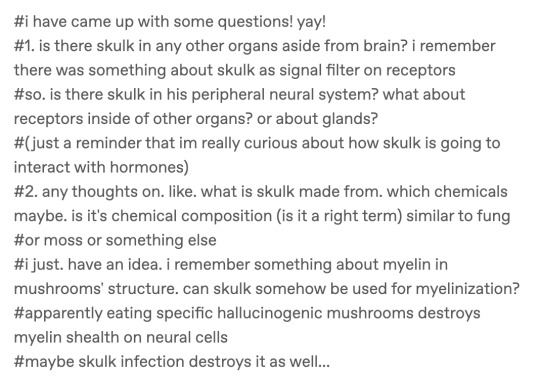
it's not in any organs that aren't the nervous system I dont think, it's only there to help with cognition and processing and stuff. there MIGHT be some in his PNS? That or theres like a stopping point right before signals get to the brain where the message gets read and converted to a message skulk can read. there IS specific like skulk set up in his ears (and maybe nose and eyes and tastebuds idk though) which I also made a diagram for but im on my laptop so i dont have it rn
YESYEYSEYS I THINK THATD BE SO COOL... I think in terms of composition it'd be closest to fungi cells, but a little like viruses? where i think it DOES have normal eukaryotic cell stuff, but there's almost no energy for it to get in the deep dark so it evolved to spread like a virus (invading other cells) even though it could replicate by itself. the skulk in wifies brain can like get enough nutrients to easily divide normally so i think hes okay most of the time, but it still ultimately wants to consume dead cells so if the skulk escapes where it's designed to be it just turns into a normal skulk infection, and THEN it starts eating at the myelin shealth ^^ idk if this makes sense i might change some of it LMAO
#connie rants#skulkfies#theres only a few clones (that are alive post-debunk) with skulk brain i think just bc it's. really risky to use a PATHOGEN as biotech#so a lot of them either develop an infection or the skulk brain just doesn't work#24 (TO ME) is one of the only successful skulk clones#pineskulk
4 notes
·
View notes
Text
something something organisms are classified based on what kind of cells they have but the cells themselves do not fit into those categories something something
confuses our brain
plant cell makes a plant a plant, but a plant cell is not a plant and is, in fact, something completely different
same goes for eukaryotes
btw fun fact did you know that fungi have eukaryotic cells. they’re classified differently from animals cause their specific brand of cell is funky and has chitin or whatever
so fungi are more closely related to animals than to plants
we’re still confused but that’s okay that is simply how biologicals work you are bound to be confused at some point
2 notes
·
View notes
Text
Selected recurrent patterns or "laws" of evolution, of potential use for speculative biology. List compiled by Neocene's Pavel Volkov, who in turn credits its content to Nikolay Rejmers (original presumably in Russian). These are guidelines, and not necessarily scientifically rigorous.
Dollo's Law, or irreversibility of evolution: organisms do not evolve back into their own ancestors. When mammals returned to the sea, they did not develop gills and dermal scales and change back into fish: they became whales or seals or manatees, who retain mammalian traits and show marks of land-dwelling ancestry.
Roulliet's law, or increase of complexity: both organisms and ecosystems tend to become more complex over time, with subparts that are increasingly differentiated and integrated. This one is dodgier: there are many examples of simplification over time when it is selected for, for example in parasites. At least, over very large time scales, the maximum achievable complexity seems to increase.
Law of unlimited change: there is no point at which a species or system is complete and has finished evolving. Stasis only occurs when there is strong selective pressure in favor of it, and organism can always adapt to chaging conditions if they are not beyond the limits of survival.
Law of pre-adaptation or exaptation: new structures do not appear ex novo. When a new organ or behavior is developed, it is a modification or a re-purposing of something that already existed. Bone tissue probably evolved as reserves of energy before it was suitable to build an internal skeleton from, and feathers most likely evolved for thermal isolation and display before they were refined enough for flight.
Law of increasing variety: diversity at all levels tends to increase over time. While some forms originate from hybridization, most importantly the Eukaryotic cells, generally one ancestor species tends to leave many descendants, if it has any at all.
Law of Severtsov or of Eldredge-Gould or of punctuated equilibrium: while evolution is always slow from the human standpoint, there are moments of relatively rapid change and diversification when some especily fertile innovation appears (e.g. eyes and shells in the Cambrian), or new environments become inhabitable (e.g. continental surface in the Devonian), or disaster clears out space (e.g. at the end of the Permian or Cretaceous), followed by relative stability once all low-hanging fruit has been picked.
Law of environmental conformity: changes in the structure and functions of organisms follow the features or their environment, but the specifics of those changes depend on the structural and developmental constraints of the organisms. Squids and dolphins both have spindle-shaped bodies because physics make it necessary to move quickly through water, but water is broken by the anterior end of the skull in dolphins and by the posterior end of the mantle in squids. Superficial similarity is due to shared environment, deep structural similarity to shared ancestry.
Cope's and Marsh's laws: the most highly specialized members of a group (which often includes the physically largest) tend to go extinct first when conditions change. It is the generalist, least specialized members that usually survive and give rise to the next generations of specialists.
Deperet's law of increasing specialization: once a lineage has started to specialize for a particular niche, lifestyle, or resource, it will keep specializing in the same direction, as any deviation would be outcompeted by the rest. In contrast, their generalist ancestors can survive with a marginal presence in multiple niches.
Osborn's law, or adaptive radiation: as the previous takes place, different lines of descent from a common ancestor become increasingly different in form and specializations.
Shmalhausen's law, or increasing integration: over time, complex systems also tend to become increasingly integrated, with components (e.g. organs of an organism, or species in a symbiotic relationship) being increasingly indispensable to the whole, and increasingly tightly controlled.
232 notes
·
View notes
Text
Spectember D28: Spec at the Cell level

Is not strange for space traveling ships to find unusual concentrations of biological matter around some solar systems, probably expelled from some icy moon or from asteroids that are disintegrating, through a unique case happened through the investigation of a crumbling space super structure, upon reaching a space station the ship used for the travel showed a considerable damage in the side of the isolation panels, which was covered by a dark slime-like goo that for the time passed from the exploration of the ruins to reaching a space station it was noticeable it grew up on the surface as originally were spotted as small dot that partially were clean, and even managed to corrode the surface making it a hazard to be checked out before it could spread to other gear.
What was found out was something more peculiar than a strange corrosive element and more of an organism thriving of feeding of artificial parts of the remains of the super structure, nicknamed the Cecisolus, as far it was analyzed this was a mat colony made of thousands of eukaryote like organisms with a simple nuclei and different organelles, through over it there was a second layer of the body membrane which on one section was concentrated few more layers of dead tissue reinforced with Melanin in high quantity, within them there were multiple chains of chemical connections that integrated within some organelles which in reaction to sunlight radiation produce a reaction that is converted to energy and the Melanin reflect the rest to avoid any mutation of the cell, as the energy is transferred the organism proceed to digest the artificial spaceship material into molecules useful for their survival, disposing of the rest into space or out of the cell in the form of a dark soot.
The process seems to take days and even days to happen, probably for the energy that takes to break the compounds. In a second expedition in the remains ancient super structure it was found more colonial mats great quantities, specially around of what was identified as electricity or energy conducts and infrastructure. There has been some speculation of such correlation that the mats was once part of a organic technological system created by the extinct civilization artificers of the megastructure millions of years ago, a system that collected the solar energy of the star like solar panels and regenerated itself by feeding it specific chemicals, but on some point after abandoning the super structure the photonic collector organism might have suffered of some mutations upon a failure of their facility or a disastrous event, spreading and likely devouring the space artifact, which many researchers are considering the main reason why this ancient space habitat became a total ruin.
35 notes
·
View notes
Text
prokaryotes
hello! this is the first of (hopefully) many study posts. today i'm covering prokaryotes, specifically what they are and how they function. i am a student and not an expert in any of this, so please feel free to correct any incorrect information, or ask questions if you have anything you want clarified!
evolution
prokaryotes (organisms that make up domains bacteria and archaea) have incredible evolutionary success, which has allowed them to become the most widespread organisms on earth. their small size and insanely rapid reproduction rates is one trait that has allowed them this success - because of how quickly they can reproduce, there is a very short span of time between evolution. this plus frequent mutations equal super saiyan evolution speeds!
prokaryotes also have a wide range of adaptations, which allows them to live in a wide variety of environments, including very extreme ones.
so what are prokaryotes?
prokaryotes are single-celled organisms with no nucleus or membrane-bound organelles. as far as we know, they are the first organisms to inhabit earth. because they have been around for literally billions of years, they have incredible diversity.
prokaryotes are itty-bitty, even compared to eukaryotic cells. they typically range from 0.5-5 micrometers. one notable exception, however, is Thiomargarita namibiensis, which can be up to 750 micrometers (bigger than a poppy seed).
what do they look like??
there are three common shapes that prokaryotes come in: cocci (circular/ovular. little orb guys.), bacilli (rod shaped, think bacteria depictions in media. the beauty standard, if you will.), and spirilla (wiggly corkscrew guys. can also resemble commas or coils).
cocci can hang out alone or form chains with their buddies; sometimes they'll bunch up like grapes. bacilli like to be alone, but sometimes they'll form polite little lines with each other to make long rods. spirilla can be found alone or in chains.
cell surface structures
almost all prokaryotes have a cell wall, which holds its shape and prevents it from exploding into smithereens in hypotonic (low osmotic pressure) environments. prokaryotic cell walls are made of peptidoglycan. archaeabacteria are the weirdos in this, their cell walls are made of polysaccharides and proteins.
bacteria can be sorted by differences in their cell-wall, identified through a process called gram stain. i'll probably make a mini-post talking about gram stain and link it here when i do.
most prokaryotes also have some sort of sticky layer on the outside, called a capsule (or, if less organized, a slime layer). these, as you may have figured out, allow prokaryotes to stick to things. they can also prevent dehydration.
many prokaryotes are capable of taxis - this means they are able to purposefully move in a specific direction in response to external stimuli. the most common structure used for this is a flagellum, which look like little wiggly tails. if you've ever played spore you are probably familiar with these things, and just like in spore they can be pretty much anywhere on an organism.
internal structures
as mentioned above, prokaryotes do not have a nucleus or membrane bound organelles. they're actually pretty simple organisms overall. they usually only have one circular chromosome contained inside of their nucleoid (which is different from a nucleus). additionally, they have DNA molecules that can replicate independently called plasmids.
reproduction
most prokaryotes reproduce via binary fission, which means the cell doubles itself and then the doubles double themselves and then so on and so forth. think like the game 2048.
"but b!" you say, "what about genetic diversity?? if they're just making clones of themselves then there is none!" that is correct! that's where mutations come into play. since there is no exchange of alleles in asexual reproduction, prokaryotes heavily rely on random mutations.
there is another phenomenon that can occur called genetic recombination, which is when you mash together dna from two different organisms. "but... but there's no sex??" correct again! instead, transformation, conjugation, and transduction is how this swap happens. i may go into more detail about this in a mini-post - i will link it here if i do so.
i also wanna make a quick note about dna transfer between different species, which my textbook refers to as "horizontal gene transfer" which sound like one hell of a euphemism to me personally. (for clarification's sake, horizontal gene transfer is a scientific term).
metabolism
the are four major "modes" that prokaryotes acquire nutrition: photoautotroph, chemoautotroph, photoheterotroph, and chemoheterotroph. photo- means light, and chemo- means chemicals. this combined with autotrophs referring to organisms that can create their own food and heterotrophs referring to organism who source food externally makes it relatively simple to interpret these terms. a prokaryote may fall under one or multiple of these categories.
there are also differences in how prokaryotes interact with oxygen. obligate aerobes need oxygen to live and reproduce, while obligate anaerobes are poisoned by oxygen and must get chemical energy through other means.
often prokaryotic cells will work together to carry out metabolic processes that cannot be completes by a lone cell. as these cells band together they may form what is called a biofilm, which recruits even more cells and makes the colonies even bigger.
my next post will probably be an overview of prokaryotic phylogeny + diversity. i'm still figuring out how to format things, so i may try and break down subjects a bit more so i don't end up with such long posts.
#biology#prokaryotes#studyblr#b studies#i am not the biggest fan of microscopic organisms#but they're very important to learn about!#if you find them a bit boring i find that anthropomorphizing them can help make them more interesting
4 notes
·
View notes
Text
Hi! what a bummer that your account was deleted. I saw the tags on the three domains post and just wanted to answer. The current hypothesis is that eukaryotes originated when an archaeon of the Asgardarchaota clade (iirc more specifically from Heimdallarchaeota) entered a symbiotic with an α-proteobacteria. This symbiont became kind of entangled in membrane protrusions produced by the archaeon until eventually it lived complitely inside it, and thus appeared the first eukaryote (kind of more complicated and involves several metabolical exchanges, i can explain more if need be). If this hypothesis is true, not only are eukaryotes closer to archaea than to bacteria, but they'd also be directly descended from them. Since keeping the clade archaea without including eukarya would be paraphyletic, this leads to what is called the two domain theory, where eukaryotes are grouped inside archaea :)
(ask from @0ctogus)
Are the archaea incl eukaryotes grouped inside bacteria?
Also, what is an alpha proteobacteria? How did it end up with another organism’s DNA in it?
#i see an ask from you and know my taxonomy knowledge is about to triple. and on that day we rejoice#THANK YOU SO MUCH#also where do you get so your information from? is it just school / uni?
10 notes
·
View notes
Text
Eukaryogenesis
Presently, it is understood that there are three domains of life. There is the eukarya, which is the domain consisting of the highest degree of complexity per cell and constitutes organisms such as plants, animals, and fungi. The other two are sub-branches of the prokarya, wherein the individual cells are less complex than the eukarya, and these are the bacteria and the archaea. Archaea, specifically, are a relatively new discovery (in terms of the scientific timescale) as their existence was first reported by Dr. Carl Woese in 1977.
Over time, the tree of life has undergone many changes, but the current most popular form is the below image, which was published in Nature Microbiology in 2016 and is based on 16S rRNA sequences (these ribosomal RNAs are ubiquitous in all life, and thus are a solid candidate for tracking evolutionary lineages)
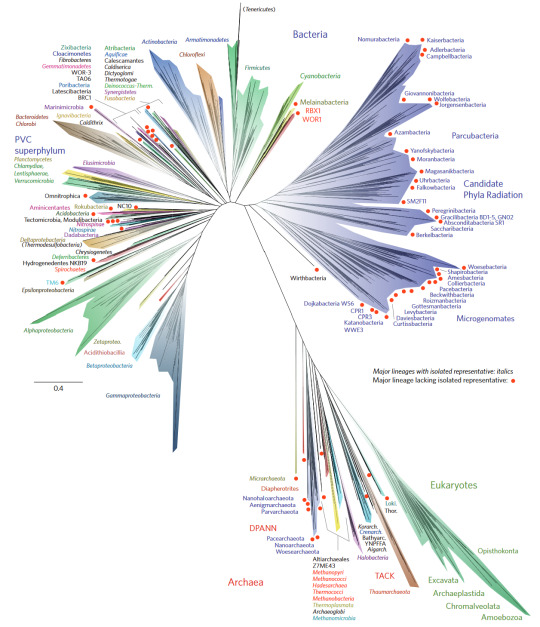
There are two interesting features of this tree. The first is the upper right branch, which consists entirely of candidatus bacterial species. Candidatus indicates the the organism has been identified, but it has not been isolated and grown in a homoculture. Some species may never escape this category as it stands as some are obligate syntrophs, meaning that they cannot be grown without a co-culture that provides necessary nutrients. The second feature is the bottom right corner, in which the archaea and eukarya are located on the same arm, with the eukaryotes branching off just after the Asgard archaea.
An interesting feature of archaeal species is that they are a sort-of middle ground between the bacteria and the eukarya. What I mean by this is that, despite being prokaryotes like bacteria, they contain proteins that are more eukaryote-like. Additionally, the rRNA of some Asgard archaea actually contains elongation segments, something previously considered a trait exclusive to eukaryotes.
With these cursory points in mind, a current hypothesis for an aspect of eukaryogenesis (the origin of eukarya), specifically the aquisition of the mitochondria and/or the chloroplast, is that an archaeal species and a bacterial species were closely symbiotic to the point that the archaea engulfed the bacteria and fully incorporated it into its metabolism and replication cycle. This hypothesis is called "endosymbiosis."
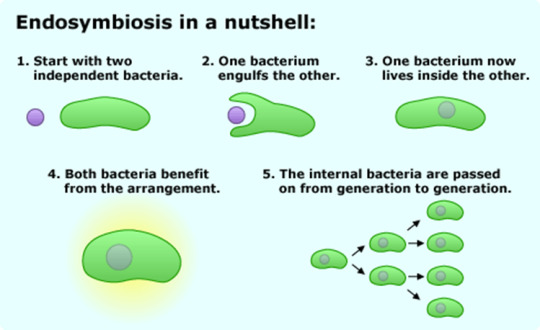
Evidence for the mitochondria and chloroplast having their origins as bacterial species is the presence of a double membrane (one would have been the bacteria's, and one would have been the proto-eukaryote's), their own distinct ribosomes, and their own DNA.
How exactly this occurred is hotly debated, but two methods of engulfment include standard phagocytosis, and the other involves filaments of cytoplasm-containing membrane called "blebs" that could slowly build up around the symbiote. An example of the latter has been observed in the species Candidatus Prometheoarchaeum syntrophicum, strain MK-D1, which is an example of Lokiarchaeota (a subsection of the Asgard archaeota). In the paper "Isolation of an archaeon at the prokaryote-eukaryote interface" by Itachi et al. (2020), it was observed to grow blebs around its syntrophs, namely Halodesulfovibrio bacteria and Methanagenium archeaon.
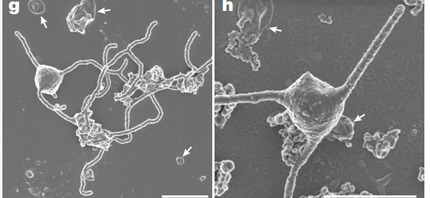
As might be gathered by its classification as Candidatus, it was incapable of growth without its syntrophs due to an "incomplete" metabolism where the syntrophs covered the crucial gaps.
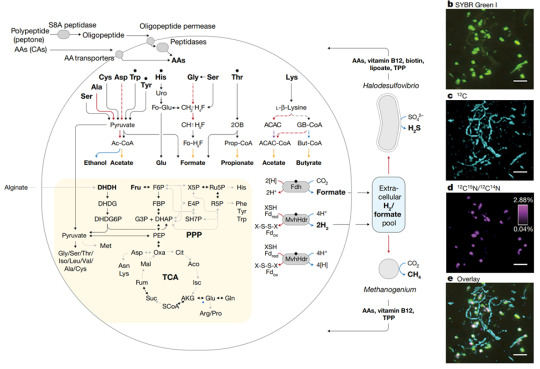
Based on their results, they proposed their own model for Endosymbiotic Eukaryogenesis, which they dubbed "Entangle, Engulf, Endogenize."
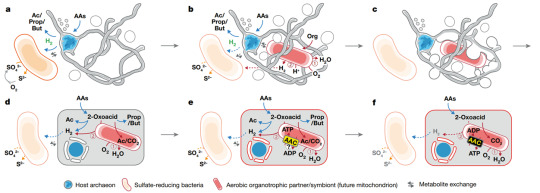
However, it is important to note that these cells were grown in optimized growth conditions. Originally, these cells came from a deep-sea sediment core, meaning that they are more accustomed to minimal nutrient conditions. As such, the optimized growth conditions may have resulted in the formation of these blebs as the cells struggled to self-regulate under overly nutrient-rich conditions. So, as always, more research would need to be done on these cells to make sure the bleb formation was not simply a side-product of lab growth conditions. Furthermore, this only accounts for one aspect of eukaryogenesis and does not account for the formation of the nucleus.
#If you need help accessing any of the sources just lmk#If you have any questions on the subject also feel free to ask#microbiology#eukaryogenesis#eukaryotes#cells#biochemistry#science#literature review
3 notes
·
View notes